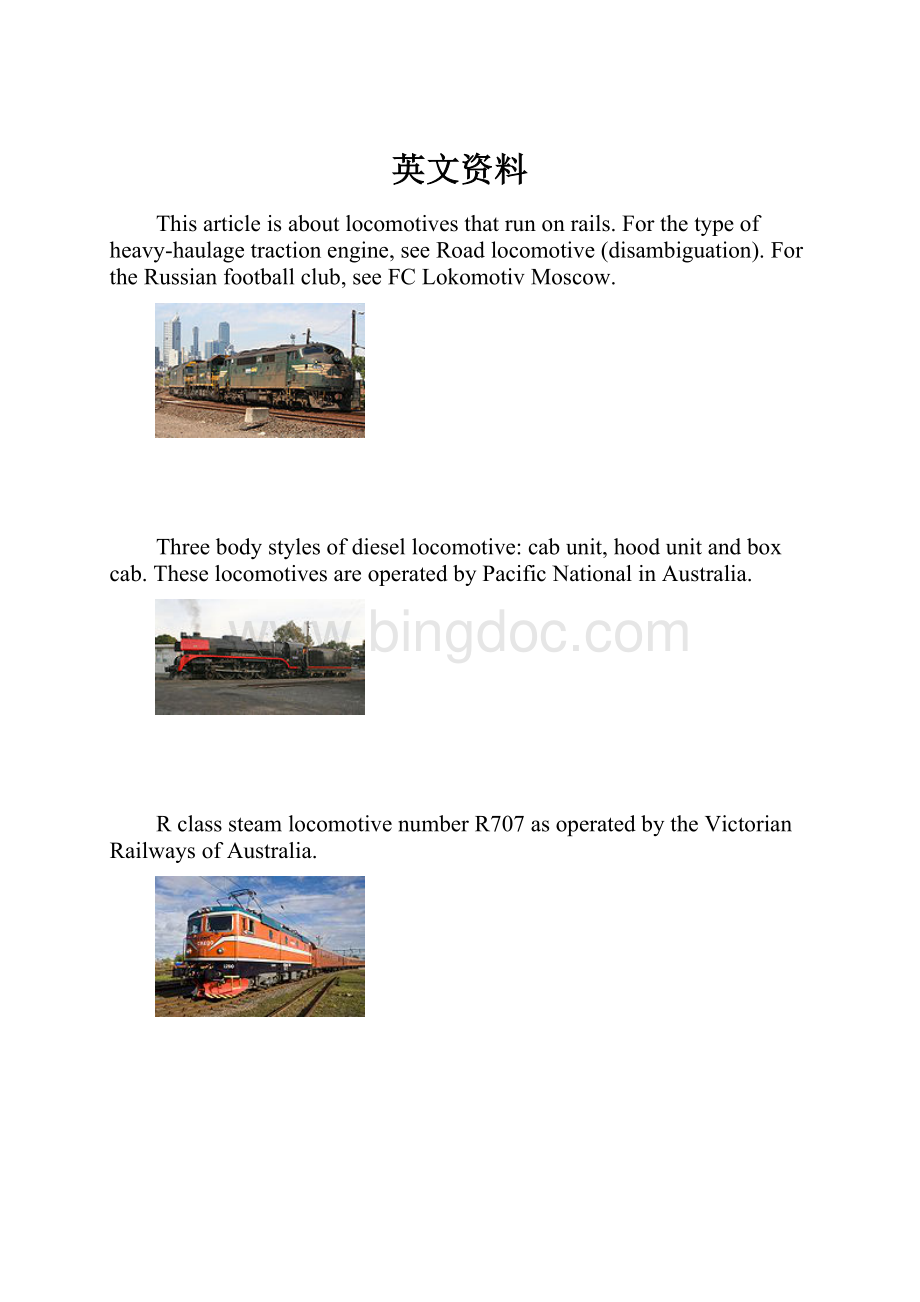英文资料.docx
《英文资料.docx》由会员分享,可在线阅读,更多相关《英文资料.docx(12页珍藏版)》请在冰点文库上搜索。

英文资料
Thisarticleisaboutlocomotivesthatrunonrails.Forthetypeofheavy-haulagetractionengine,seeRoadlocomotive(disambiguation).FortheRussianfootballclub,seeFCLokomotivMoscow.
Threebodystylesofdiesellocomotive:
cabunit,hoodunitandboxcab.TheselocomotivesareoperatedbyPacificNationalinAustralia.
RclasssteamlocomotivenumberR707asoperatedbytheVictorianRailwaysofAustralia.
AGreenCargoRC4classelectriclocomotiverepaintedinitsoriginalliveryfortheSwedish150-yearrailwayanniversaryin2006.
Alocomotiveisarailwayvehiclethatprovidesthemotivepowerforatrain.ThewordoriginatesfromtheLatinloco–"fromaplace",ablativeoflocus,"place"+MedievalLatinmotivus,"causingmotion",andisashortenedformofthetermlocomotiveengine,[1]firstusedintheearly19thcenturytodistinguishbetweenmobileandstationarysteamengines.
Alocomotivehasnopayloadcapacityofitsown,anditssolepurposeistomovethetrainalongthetracks.Incontrast,sometrainshaveself-propelledpayload-carryingvehicles.Thesearenotnormallyconsideredlocomotives,andmaybereferredtoasmultipleunits,motorcoachesorrailcars.Theuseoftheseself-propelledvehiclesisincreasinglycommonforpassengertrains,butrareforfreight(seeCargoSprinter).Vehicleswhichprovidemotivepowertohaulanunpoweredtrain,butarenotgenerallyconsideredlocomotivesbecausetheyhavepayloadspaceorarerarelydetachedfromtheirtrains,areknownaspowercars.
Traditionally,locomotivespulltrainsfromthefront.Increasinglycommonispush-pulloperation,wherealocomotivepullsthetraininonedirectionandpushesitintheother,andcanbecontrolledfromacontrolcabattheotherendofthetrain.
Origins
Seealso:
Historyofrailtransport andCategory:
Earlysteamlocomotives
Firstpassengerrailway,L&MR
ThefirstsuccessfullocomotiveswerebuiltbyCornishinventorRichardTrevithick.In1804hisunnamedsteamlocomotivehauledatrainalongthetramwayofthePenydarrenironworks,nearMerthyrTydfilinWales.Althoughthelocomotivehauledatrainof10tonsofironand70passengersinfivewagonsoverninemiles(14 km),itwastooheavyforthecastironrailsusedatthetime.Thelocomotiveonlyranthreetripsbeforeitwasabandoned.TrevithickbuiltaseriesoflocomotivesafterthePenydarrenexperiment,includingonewhichranatacollieryinTynesideinnorthernEngland,whereitwasseenbytheyoungGeorgeStephenson.[2]
ThefirstcommerciallysuccessfulsteamlocomotivewasMatthewMurray'sracklocomotive,Salamanca,builtforthenarrowgaugeMiddletonRailwayin1812.Thiswasfollowedin1813bythePuffingBillybuiltbyChristopherBlackettandWilliamHedleyfortheWylamCollieryRailway,thefirstsuccessfullocomotiverunningbyadhesiononly.PuffingBillyisnowondisplayintheScienceMuseuminLondon,theoldestlocomotiveinexistence.[3]
In1814GeorgeStephenson,inspiredbytheearlylocomotivesofTrevithickandHedleypersuadedthemanageroftheKillingworthcollierywhereheworkedtoallowhimtobuildasteam-poweredmachine.HebuilttheBlücher,oneofthefirstsuccessfulflanged-wheeladhesionlocomotives.Stephensonplayedapivotalroleinthedevelopmentandwidespreadadoptionofsteamlocomotives.Hisdesignsimprovedontheworkofthepioneers.In1825hebuilttheLocomotionfortheStocktonandDarlingtonRailway,northeastEngland,whichbecamethefirstpublicsteamrailway.In1829hebuiltTheRocketwhichwasenteredinandwontheRainhillTrials.ThissuccessledtoStephensonestablishinghiscompanyasthepre-eminentbuilderofsteamlocomotivesusedonrailwaysintheUnitedKingdom,theUnitedStatesandmuchofEurope.[4]Thefirstintercitypassengerrailway,LiverpoolandManchesterRailway,openedin1830,makingexclusiveuseofsteampowerforbothpassengerandfreighttrains.
Locomotivesvs.multipleunits
Advantagesoflocomotives
Therearemanyreasonswhythemotivepowerfortrainshasbeentraditionallyisolatedinalocomotive,ratherthaninself-propelledvehicles.[5]
Ease
Shouldthelocomotivefail,itiseasytoreplaceitwithanother.Failureormaintenanceofthemotivepowerunitdoesnotrequiretakingtheentiretrainoutofservice.
Maximumutilizationofpowercars
Idletrainswastecostlymotivepowerresources.Separatelocomotivesenablecostlymotivepowerassetstobemovedaroundasneeded.
Flexibility
Largelocomotivescanbesubstitutedforsmalllocomotiveswherethegradesaresteeperandmorepowerisneeded.A'passenger'locomotivecanalsobeusedforfreightdutiesifneeded,andviceversa.
Obsolescencecycles
Separatingthemotivepowerfrompayload-haulingcarsenablesonetobereplacedwithoutaffectingtheother.Attimeslocomotiveshavebecomeobsoletewhentheircarswerenot,andviceversa.
Safety
Incaseofanaccident,thelocomotivemayactasbufferzonefortherestofthetrain.Ifanobstacleisencounteredontheline,theheaviermassofalocomotiveislesslikelytobedeviatedfromitsnormalcourse.Alsoitmaybesaferintheeventoffireespeciallywithdiesellocomotives.
Noise
Asinglesourceoftractivepower,whichmeansonlymotorsinoneplace,meansthatthetrainwillbequieterthanwithmultipleunitoperation,whereoneormoremotorsarelocatedundereverycarriage.Thenoiseproblemisparticularlypresentindieselmultipleunits.
Advantagesofmultipleunits
Thereareseveraladvantagesofmultipleunit(MU)trainscomparedtolocomotives.
Energyefficiency
Multipleunitsaremoreenergyefficientthanlocomotive-hauledtrainsandmorenimble,especiallyongrades,asmuchmoreofthetrain'sweight(sometimesallofit)isplacedondrivenwheels,ratherthansufferthedeadweightofunpoweredcoaches.
Noneedtoturnlocomotive
Manymultipleunitshavecabsatbothends,thetrainmaybereversedwithoutuncoupling/re-couplingthelocomotive,givingquickerturnaroundtimes,reducingcrewcosts,andenhancingsafety.Inpractice,thedevelopmentofdrivingvantrailersandcabcarshasremovedtheneedforlocomotivestorun-around,givingeasybi-directionalworkingandremovingthisMUadvantage.
Reliability
Asmultipleunittrainshavemultipleengines,thefailureofoneenginedoesnotpreventthetrainfromcontinuingitsjourney.Alocomotivedrawnpassengertraintypicallyonlyhasonepowerunit,meaningthefailureofthiscausesthetraintobedisabled.However,somelocomotivehauledpassengertrainsmayutilizemorethanonelocomotive,asdomanylocomotivehauledfreighttrains,andsoareabletocontinueatreducedspeedafterthefailureofonelocomotive.
Safety
Multipleunitsnormallyhavecompletelyindependentbrakingsystemsonallcars,meaningthefailureofthebrakesononecardoesnotpreventthebrakesthroughoutthetrainfromoperatingsafely.
Locomotiveclassifications
Motivepower
Locomotivesmaygeneratetheirpowerfromfuel(wood,coal,petroleumornaturalgas),ortheymaytakepowerfromanoutsidesourceofelectricity.Itiscommontoclassifylocomotivesbytheirsourceofenergy.Thecommononesinclude:
Steam
Inthe19thcenturythefirstrailwaylocomotiveswerepoweredbysteam,usuallygeneratedbyburningcoal.Becausesteamlocomotivesincludedoneormoresteamengines,theyaresometimesreferredtoas"steamengines".ThesteamlocomotiveremainedbyfarthemostcommontypeoflocomotiveuntilafterWorldWarII.[6]
ThefirststeamlocomotivewasbuiltbyRichardTrevithick;itfirstranon21February1804,althoughitwassomeyearsbeforesteamlocomotivedesignbecameeconomicallypractical.[2].ThefirstcommercialuseofasteamlocomotivewasTheSalamancaonthenarrowgaugeMiddletonRailwayinLeedsin1812.ThelocomotiveFairyQueen,builtin1855runsbetweenDelhiandAlwarinIndiaandistheoldeststeamlocomotiveinregular(albeittourist-only)serviceintheworld,andtheoldeststeamlocomotiveoperatingonamainline.[7][8]
Theall-timespeedrecordforsteamtrainsisheldbyanLNERClassA44-6-2PacificlocomotiveoftheLNERintheUnitedKingdom,number4468Mallard,whichpullingsixcarriages(plusadynamometercar)reached126 mph(203 km/h)onaslightdownhillgradientdownStokeBankon3July1938.[9]AerodynamicpassengerlocomotivesinGermanyattainedspeedsveryclosetothisandduetothedifficultiesofadequatelybalancingandlubricatingtherunninggear,thisisgenerallythoughttobeclosetothepracticablelimitforadirect-coupledsteamlocomotive.[10]
Beforethemiddleofthe20thcentury,electricanddiesel-electriclocomotivesbeganreplacingsteamlocomotives.Steamlocomotivesarelessefficientthantheirmoremoderndieselandelectriccounterpartsandrequiremuchgreatermanpowertooperateandservice.[11]BritishRailfiguresshowedthecostofcrewingandfuellingasteamlocomotivewassometwoandahalftimesthatofdieselpower,andthedailymileageachievablewasfarlower.Aslabourcostsrose,particularlyafterthesecondworldwar,non-steamtechnologiesbecamemuchmorecost-efficient.[citationneeded]Bytheendofthe1960s-1970s,mostwesterncountrieshadcompletelyreplacedsteamlocomotivesinpassengerservice.Freightlocomotivesgenerallywerereplacedlater.Otherdesigns,suchaslocomotivespoweredbygasturbines,havebeenexperimentedwith,buthaveseenlittleuse,mainlyduetohighfuelcosts.
Bytheendofthe20thcentury,almosttheonlysteampowerstillinregularuseinNorthAmericaandWesternEuropeancountrieswasonheritagerailwayslargelyaimedattouristsand/orrailroadhobbyists,knownas'railfans'or'rai